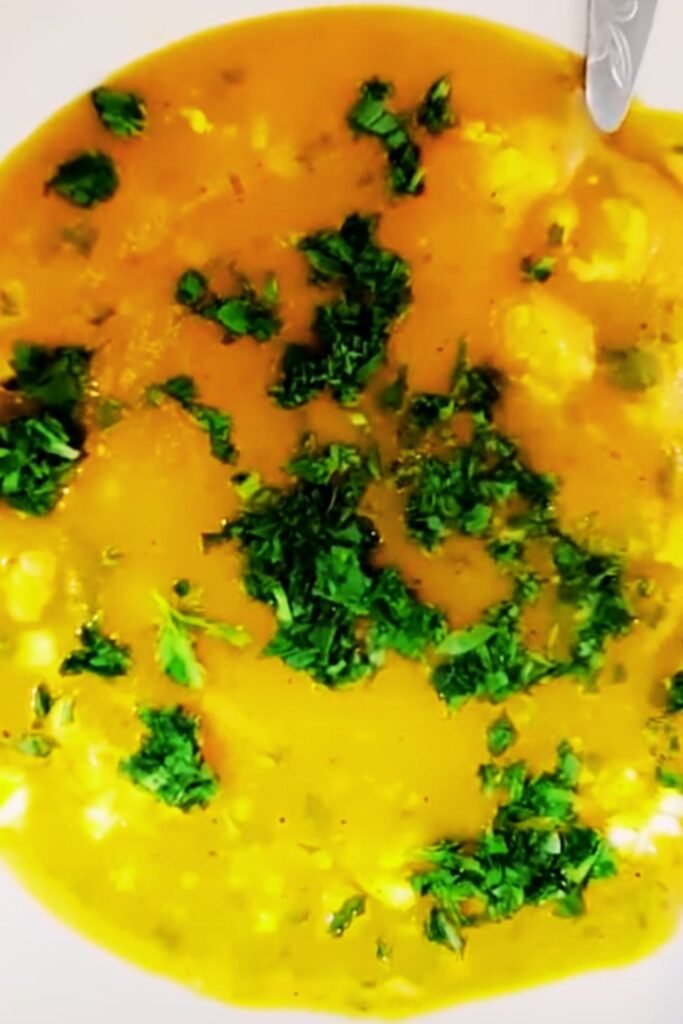There’s something magical about the way a steaming bowl of homemade soup can instantly warm both body and soul. As the autumn leaves begin to fall and a chill fills the air, I find myself gravitating toward my kitchen, eager to transform humble root vegetables into something extraordinary. My carrot potato soup recipe has been refined over countless Sunday afternoons, each batch a little better than the last, until it evolved into the perfect harmony of flavors that I’m excited to share with you today.
This vibrant orange soup isn’t just visually stunning; it packs a nutritional punch while delivering the kind of comfort that makes you close your eyes with each spoonful. The natural sweetness of carrots balances perfectly with the earthy heartiness of potatoes, creating a soup that’s both substantive and surprisingly complex in flavor.
Whether you’re a seasoned home cook or just beginning your culinary journey, this recipe welcomes you with its forgiving nature and adaptable character. Let me walk you through creating this soul-warming dish that’s equally perfect for a quiet night in or as an impressive starter for your next gathering.
The Magic of Root Vegetables: Why This Combination Works
Root vegetables are nature’s answer to cold weather. Developing underground, they store nutrients and sugars that translate into incredible depth of flavor when cooked properly. The combination of carrots and potatoes in particular creates a balanced foundation that’s:
- Naturally sweet yet savory
- Hearty without being heavy
- Nutritionally dense while feeling indulgent
- Budget-friendly but luxurious in taste
- Versatile enough to please diverse palates
The carrots bring natural sweetness, vibrant color, and a healthy dose of beta-carotene, while potatoes add creaminess, substance, and that comforting quality that makes soup feel like a proper meal. Together, they create something greater than the sum of their parts.
Ingredients: Simple Components, Extraordinary Results
One of the beauties of this soup is how it transforms everyday ingredients into something special. Here’s what you’ll need:
Main Ingredients:
- 1 pound (about 6 medium) carrots, peeled and roughly chopped
- 1 pound (about 3 medium) Yukon Gold potatoes, peeled and diced
- 1 large yellow onion, diced
- 3 cloves garlic, minced
- 4 cups vegetable broth (homemade or low-sodium store-bought)
- 2 tablespoons olive oil
- 1 teaspoon fresh thyme leaves (or ½ teaspoon dried)
- 1 bay leaf
- ½ cup heavy cream or full-fat coconut milk (for dairy-free option)
- Salt and freshly ground black pepper to taste
Optional Garnishes:
- Fresh chives, finely chopped
- Crème fraîche or Greek yogurt
- Toasted pumpkin seeds
- Homemade croutons
- Extra virgin olive oil, for drizzling
- Microgreens or fresh herbs
Ingredient Notes: Choosing the Best
What elevates a good soup to a great one often comes down to ingredient quality. Here are some insights on selections that make a difference:
Carrots: Look for firm, bright orange carrots with minimal cracks. If you can find them with the greens still attached, that’s often a sign of freshness. I prefer medium-sized carrots as they tend to have the best flavor balance—not too bitter like some larger ones can be, and not too woody.
Potatoes: Yukon Golds are my go-to for this soup because they have a naturally buttery flavor and break down just enough to add creaminess while maintaining some texture. Russets will work in a pinch but tend to make the soup a bit too starchy. Red potatoes don’t break down as well for this application.
Broth: While homemade vegetable broth is unbeatable, a good quality store-bought version works wonderfully. Look for low-sodium options that allow you to control the saltiness. If using store-bought, I often enhance it by simmering with a few extra vegetable scraps and herbs for 20 minutes before straining and using in the soup.
Equipment: Setting Yourself Up for Success
You don’t need fancy equipment to make wonderful soup, but having the right tools makes the process smoother:
- Large heavy-bottomed pot or Dutch oven
- Sharp chef’s knife and cutting board
- Immersion blender (or standard blender)
- Wooden spoon
- Ladle
- Measuring cups and spoons
The heavy-bottomed pot is particularly important for developing flavors without scorching, while an immersion blender makes the pureeing process much simpler and safer than transferring hot soup to a standard blender in batches.
The Method: Creating Layers of Flavor
Great soup is all about building flavors systematically. Here’s my step-by-step approach:
Step 1: Laying the Foundation
- Heat olive oil in your pot over medium heat until it shimmers.
- Add diced onions with a pinch of salt and sauté for 5-7 minutes until translucent and beginning to turn golden at the edges.
- Add minced garlic and cook for another 30-45 seconds until fragrant, being careful not to let it brown or burn.
Step 2: Building the Body
- Add chopped carrots and potatoes to the pot, stirring to coat with the aromatic oil.
- Sauté for 3-4 minutes until the vegetables begin to soften slightly at the edges.
- Add thyme and bay leaf, stirring to incorporate.
Step 3: The Simmer
- Pour in the vegetable broth and bring to a gentle boil.
- Reduce heat to maintain a simmer, cover partially, and cook for 20-25 minutes until the vegetables are completely tender when pierced with a fork.
- Check occasionally and adjust heat as needed to maintain a gentle simmer.
Step 4: Transforming Texture
- Remove the bay leaf.
- Use an immersion blender directly in the pot to purée the soup to your desired consistency. I prefer mine mostly smooth with a few small vegetable pieces for texture.
- If using a standard blender, work in batches, never filling more than halfway, and always start on the lowest speed with the lid slightly vented to allow steam to escape.
Step 5: Finishing Touches
- Return the soup to the pot if you used a standard blender.
- Stir in the heavy cream or coconut milk.
- Warm through over low heat, being careful not to boil.
- Taste and adjust seasoning with salt and pepper.

Variations: Making It Your Own
The beauty of this soup lies in its adaptability. Here are some of my favorite variations:
Flavor Enhancers
- Spice it up: Add 1 teaspoon curry powder or garam masala when sautéing the onions for an Indian-inspired twist.
- Herb infusion: Bundle 2-3 sprigs each of thyme, rosemary, and parsley with kitchen twine and simmer with the soup, removing before blending.
- Roasted garlic: Replace regular garlic with a whole head of roasted garlic for mellower, sweeter garlic notes.
- Ginger touch: Add 1 tablespoon grated fresh ginger with the garlic for brightness and subtle warmth.
Dietary Adaptations
- Vegan version: Use coconut milk instead of cream and ensure your broth is vegetable-based.
- Lower calorie: Substitute the cream with evaporated skim milk or unsweetened almond milk.
- Extra protein: Stir in 1 cup of cooked white beans before blending for a protein boost.
Texture Variations
- Chunky style: Set aside 1 cup of the cooked vegetables before blending, then stir back in afterward.
- Super smooth: Pass the blended soup through a fine-mesh sieve for a velvety restaurant-quality finish.
- Rustic approach: Only partially blend the soup, leaving it chunky for a more rustic texture.
Nutritional Benefits: Goodness in Every Spoonful
This soup isn’t just delicious—it’s packed with nutrition that makes it as good for your body as it is for your taste buds:
| Nutrient | Benefit | Primary Source in Recipe |
|---|---|---|
| Beta-carotene | Supports eye health and immune function | Carrots |
| Vitamin C | Boosts immune system and collagen production | Carrots, potatoes |
| Potassium | Helps regulate blood pressure | Potatoes, carrots |
| Fiber | Supports digestive health | Carrots, potatoes, onions |
| Vitamin B6 | Important for brain development and function | Potatoes |
| Antioxidants | Help fight inflammation and oxidative stress | Carrots, garlic, herbs |
The combination of these nutrients makes this soup not just comfort food, but a genuinely nourishing meal that supports overall wellness—especially important during cold and flu season when we could all use an immune boost.
Serving Suggestions: Creating a Complete Meal
While this soup is satisfying on its own, here are some complementary pairings that create a well-rounded meal:
Perfect Accompaniments
- Crusty bread: A slice of warm artisan bread with salted butter is the classic pairing that never disappoints.
- Grilled cheese: The ultimate comfort food duo—try it with sharp cheddar and a touch of Dijon mustard.
- Fresh salad: Balance the warm soup with a crisp green salad with apple slices, walnuts, and a light vinaigrette.
- Protein addition: Top each bowl with roasted chickpeas or a soft-boiled egg for extra staying power.
For Special Occasions
- Serve in hollowed-out bread bowls for an impressive presentation.
- Top with a small drizzle of truffle oil for luxury (a little goes a long way!).
- Create a soup bar with various toppings so guests can customize their bowls.

Storage and Make-Ahead Tips: Practical Planning
One of the greatest attributes of this soup is how well it keeps and even improves with time:
Refrigeration
The flavors of this soup actually develop and improve after a day in the refrigerator. Store in an airtight container for up to 4 days. The soup may thicken considerably when chilled; simply thin with a splash of broth when reheating.
Freezing
This soup freezes beautifully for up to 3 months. I recommend freezing it before adding the cream, then adding fresh cream when reheating. Here’s my method:
- Cool the soup completely before freezing.
- Portion into freezer-safe containers, leaving about an inch of headspace for expansion.
- Label with the date and contents.
- Thaw overnight in the refrigerator before reheating.
- Reheat gently, stirring occasionally, and add fresh cream once hot.
Make-Ahead for Entertaining
When preparing for guests, I often make the soup up to the blending stage a day ahead, refrigerate, then reheat and add the cream just before serving. This approach not only saves time on the day of entertaining but also results in more developed flavors.
Troubleshooting: Solving Common Soup Challenges
Even experienced cooks sometimes encounter issues with soup. Here are solutions to common problems:
Problem: Soup is too thick
Solution: Add warm broth or water, a little at a time, until you reach your desired consistency.
Problem: Flavors seem flat or bland
Solution: Add a splash of acid like lemon juice or a teaspoon of vinegar, which often brightens flavors without needing more salt. Fresh herbs added at the end can also wake up the taste.
Problem: Soup separated or looks curdled after adding cream
Solution: This usually happens when cream is added to boiling-hot soup. To fix it, allow the soup to cool slightly before adding cream, or temper the cream by gradually whisking in small amounts of the hot soup before adding it to the pot.
Problem: Soup tastes too sweet
Solution: Balance sweetness with a touch of acid (lemon juice or vinegar) and/or a pinch more salt. A dash of white pepper can also help counteract excessive sweetness.

Chef’s Notes: From My Kitchen to Yours
Over the years of making this soup, I’ve collected some insights that might help you achieve the best results:
- The importance of sweating onions properly: Taking the time to properly cook your onions until translucent and just starting to color adds incredible depth to the final soup. Rushing this stage is tempting but significantly impacts the end result.
- Salt as you go: Adding small amounts of salt at different stages (when cooking onions, when adding vegetables, etc.) builds flavor more effectively than only salting at the end.
- Controlling texture: The longer you blend, the smoother your soup becomes. For the perfect balance, I blend just until smooth but still substantial—about 30-45 seconds with an immersion blender.
- Visual cue for doneness: The carrots should be completely tender—if you can easily smash one against the side of the pot with a wooden spoon, they’re ready to blend.
- The cooling effect of garnishes: Remember that cold garnishes like crème fraîche will cool your soup quickly. Serve the soup slightly hotter than you might normally if adding chilled toppings.
Questions & Answers
Is this soup gluten-free? Yes! This carrot potato soup is naturally gluten-free as written. Just be sure to check your broth ingredients if using store-bought, as some may contain trace amounts of gluten as thickeners or flavoring agents.
Can I use baby carrots instead of regular carrots? While you can use baby carrots in a pinch, I don’t recommend them for the best flavor. Baby carrots are actually larger carrots that have been mechanically peeled and shaped, and they often lack the full flavor of whole carrots. They also tend to be slightly waterier, which can affect the final texture of your soup.
How can I make this soup vegan? Easy! Simply substitute the heavy cream with full-fat coconut milk or your favorite unsweetened plant-based cream alternative. The coconut milk adds a lovely subtle sweetness that works beautifully with the carrots.
My immersion blender isn’t creating a smooth texture. What can I do? If your immersion blender isn’t powerful enough, you can use a standard blender for smoother results. Work in batches, filling the blender no more than halfway, and always start on the lowest speed with the lid slightly vented to allow steam to escape.
How can I add more protein to this soup? There are several ways to boost the protein content: stir in cooked white beans before blending; top with roasted chickpeas; add a dollop of Greek yogurt; or serve with a hard-boiled egg. For non-vegetarians, crispy bacon bits make a delicious protein-rich topping.
The soup seems thin after blending. How can I thicken it? If your soup seems too thin, continue simmering uncovered for 5-10 minutes to reduce and thicken it. Alternatively, you can blend in 2-3 additional cooked potato pieces, which will add starch and thicken the soup naturally without changing the flavor profile.
Can I make this in a slow cooker or Instant Pot? Absolutely! For slow cooker, sauté the onions and garlic in a pan first, then transfer to the slow cooker with remaining ingredients except cream. Cook on low for 6-7 hours or high for 3-4 hours. For Instant Pot, use the sauté function for the onions and garlic, add remaining ingredients except cream, and cook on high pressure for 8 minutes with a quick release. Blend and add cream after cooking.
What’s the best way to reheat this soup? Reheat gently over medium-low heat, stirring occasionally to prevent scorching on the bottom. Alternatively, microwave in 1-minute intervals at 70% power, stirring between each interval. Add a splash of broth if the soup has thickened too much during storage.
Final Thoughts: The Joy of Homemade Soup
There’s something profoundly satisfying about transforming simple ingredients into a nourishing meal that comforts and delights. This carrot potato soup represents everything I love about home cooking—it’s economical yet feels luxurious, simple yet sophisticated, familiar yet special.
As you ladle this vibrant orange soup into bowls and watch the steam rise, carrying with it the aroma of sweet carrots, earthy potatoes, and fragrant herbs, I hope you feel the same sense of accomplishment and pleasure that I do. Food is more than sustenance; it’s connection, comfort, and creativity all stirred together in one pot.
Whether you’re making this soup for yourself on a quiet evening or sharing it with loved ones around a bustling table, know that you’re participating in one of humanity’s oldest and most universal traditions—nourishing bodies and souls through thoughtfully prepared food.
So go ahead, take that first spoonful, close your eyes, and savor the moment. This is what cooking is all about.